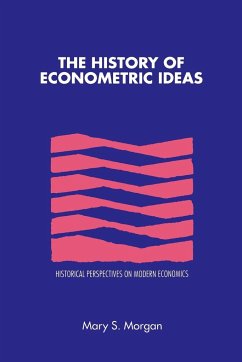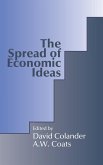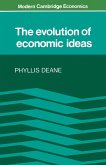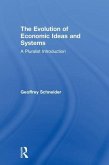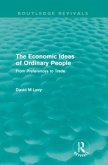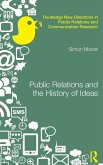- Broschiertes Buch
- Merkliste
- Auf die Merkliste
- Bewerten Bewerten
- Teilen
- Produkt teilen
- Produkterinnerung
- Produkterinnerung
This book illustrates how economists first learnt to harness statistical methods to measure and test the 'laws' of economics.
Andere Kunden interessierten sich auch für
![The Spread of Economic Ideas The Spread of Economic Ideas]() The Spread of Economic Ideas75,99 €
The Spread of Economic Ideas75,99 €![The Evolution of Economic Ideas The Evolution of Economic Ideas]() Phyllis DeaneThe Evolution of Economic Ideas51,99 €
Phyllis DeaneThe Evolution of Economic Ideas51,99 €![The Evolution of Economic Ideas and Systems The Evolution of Economic Ideas and Systems]() Geoffrey SchneiderThe Evolution of Economic Ideas and Systems222,99 €
Geoffrey SchneiderThe Evolution of Economic Ideas and Systems222,99 €![The economic ideas of ordinary people (Routledge Revivals) The economic ideas of ordinary people (Routledge Revivals)]() David LevyThe economic ideas of ordinary people (Routledge Revivals)140,99 €
David LevyThe economic ideas of ordinary people (Routledge Revivals)140,99 €![History of Economic Ideas in 20 Talks History of Economic Ideas in 20 Talks]() Cheng-chung LaiHistory of Economic Ideas in 20 Talks38,99 €
Cheng-chung LaiHistory of Economic Ideas in 20 Talks38,99 €![The economic ideas of ordinary people (Routledge Revivals) The economic ideas of ordinary people (Routledge Revivals)]() David LevyThe economic ideas of ordinary people (Routledge Revivals)36,99 €
David LevyThe economic ideas of ordinary people (Routledge Revivals)36,99 €![Public Relations and the History of Ideas Public Relations and the History of Ideas]() Simon MoorePublic Relations and the History of Ideas185,99 €
Simon MoorePublic Relations and the History of Ideas185,99 €-
-
-
This book illustrates how economists first learnt to harness statistical methods to measure and test the 'laws' of economics.
Produktdetails
- Produktdetails
- Verlag: Cambridge University Press
- Seitenzahl: 316
- Erscheinungstermin: 13. Januar 2002
- Englisch
- Abmessung: 229mm x 152mm x 19mm
- Gewicht: 515g
- ISBN-13: 9780521424653
- ISBN-10: 0521424658
- Artikelnr.: 21353559
- Herstellerkennzeichnung
- Libri GmbH
- Europaallee 1
- 36244 Bad Hersfeld
- gpsr@libri.de
- Verlag: Cambridge University Press
- Seitenzahl: 316
- Erscheinungstermin: 13. Januar 2002
- Englisch
- Abmessung: 229mm x 152mm x 19mm
- Gewicht: 515g
- ISBN-13: 9780521424653
- ISBN-10: 0521424658
- Artikelnr.: 21353559
- Herstellerkennzeichnung
- Libri GmbH
- Europaallee 1
- 36244 Bad Hersfeld
- gpsr@libri.de
List of figures
Preface
Acknowledgements
Introduction
Part I. Business Cycles: Introduction to business cycles
1. Sunspot and Venus theories of the business cycle: 1.1. Jevons' sunspot theory
1.2. Moore's Venus theory
1.3. The decline of periodic cycle analysis
2. Measuring and representing business cycles: 2.1. Juglar's credit cycle
2.2. The statistical approach of W. C. Mitchell
2.3. Persons and business barometers
2.4. The business cycle research institutes
2.5. Statistical economics and econometrics
Addendum: graphs and graphic methods
3. Random shocks enter the business cycle scene: 3.1. The experiments of Yule and Slutsky
3.2. Frisch's time-series analysis
3.3. Frisch's rocking horse model of the business cycle
4. Tinbergen and macrodynamic models: 4.1. The Dutch model
4.2. The first League of Nations' report
4.3. The second League of Nations' report
4.4. the critical reaction to Tinbergen's work
Part II. Demand Analysis: Introduction to demand analysis
5. Narrowing the data-theory gap in demand analysis: 5.1. Difficulties in early statistical measurements of demand
5.2. Static theory and time-series data
5.3. Econometric models of demand
5.4. The data-theory gap under review
6. The evolution of identification questions: 6.1. The emergence of correspondence problems
6.2. Identifying the demand curve
6.3. The identification of two relationships
6.4. Back to the single demand curve
Part III. Formal models in econometrics: Introduction to formal models
7. Errors-in-variables and errors-in equations models: 7.1. Errors and the single equation
7.2. Errors and interdependent relationships
7.3. Postscript: measurement errors and the method of instrumental variables
8. Haavelmo's probability model: 8.1. Statistics without probability
8.2. Signs of change
8.3. Haavelmo's probabilistic revolution in econometrics
8.4. The new consensus
Conclusion
References
Index.
Preface
Acknowledgements
Introduction
Part I. Business Cycles: Introduction to business cycles
1. Sunspot and Venus theories of the business cycle: 1.1. Jevons' sunspot theory
1.2. Moore's Venus theory
1.3. The decline of periodic cycle analysis
2. Measuring and representing business cycles: 2.1. Juglar's credit cycle
2.2. The statistical approach of W. C. Mitchell
2.3. Persons and business barometers
2.4. The business cycle research institutes
2.5. Statistical economics and econometrics
Addendum: graphs and graphic methods
3. Random shocks enter the business cycle scene: 3.1. The experiments of Yule and Slutsky
3.2. Frisch's time-series analysis
3.3. Frisch's rocking horse model of the business cycle
4. Tinbergen and macrodynamic models: 4.1. The Dutch model
4.2. The first League of Nations' report
4.3. The second League of Nations' report
4.4. the critical reaction to Tinbergen's work
Part II. Demand Analysis: Introduction to demand analysis
5. Narrowing the data-theory gap in demand analysis: 5.1. Difficulties in early statistical measurements of demand
5.2. Static theory and time-series data
5.3. Econometric models of demand
5.4. The data-theory gap under review
6. The evolution of identification questions: 6.1. The emergence of correspondence problems
6.2. Identifying the demand curve
6.3. The identification of two relationships
6.4. Back to the single demand curve
Part III. Formal models in econometrics: Introduction to formal models
7. Errors-in-variables and errors-in equations models: 7.1. Errors and the single equation
7.2. Errors and interdependent relationships
7.3. Postscript: measurement errors and the method of instrumental variables
8. Haavelmo's probability model: 8.1. Statistics without probability
8.2. Signs of change
8.3. Haavelmo's probabilistic revolution in econometrics
8.4. The new consensus
Conclusion
References
Index.
List of figures
Preface
Acknowledgements
Introduction
Part I. Business Cycles: Introduction to business cycles
1. Sunspot and Venus theories of the business cycle: 1.1. Jevons' sunspot theory
1.2. Moore's Venus theory
1.3. The decline of periodic cycle analysis
2. Measuring and representing business cycles: 2.1. Juglar's credit cycle
2.2. The statistical approach of W. C. Mitchell
2.3. Persons and business barometers
2.4. The business cycle research institutes
2.5. Statistical economics and econometrics
Addendum: graphs and graphic methods
3. Random shocks enter the business cycle scene: 3.1. The experiments of Yule and Slutsky
3.2. Frisch's time-series analysis
3.3. Frisch's rocking horse model of the business cycle
4. Tinbergen and macrodynamic models: 4.1. The Dutch model
4.2. The first League of Nations' report
4.3. The second League of Nations' report
4.4. the critical reaction to Tinbergen's work
Part II. Demand Analysis: Introduction to demand analysis
5. Narrowing the data-theory gap in demand analysis: 5.1. Difficulties in early statistical measurements of demand
5.2. Static theory and time-series data
5.3. Econometric models of demand
5.4. The data-theory gap under review
6. The evolution of identification questions: 6.1. The emergence of correspondence problems
6.2. Identifying the demand curve
6.3. The identification of two relationships
6.4. Back to the single demand curve
Part III. Formal models in econometrics: Introduction to formal models
7. Errors-in-variables and errors-in equations models: 7.1. Errors and the single equation
7.2. Errors and interdependent relationships
7.3. Postscript: measurement errors and the method of instrumental variables
8. Haavelmo's probability model: 8.1. Statistics without probability
8.2. Signs of change
8.3. Haavelmo's probabilistic revolution in econometrics
8.4. The new consensus
Conclusion
References
Index.
Preface
Acknowledgements
Introduction
Part I. Business Cycles: Introduction to business cycles
1. Sunspot and Venus theories of the business cycle: 1.1. Jevons' sunspot theory
1.2. Moore's Venus theory
1.3. The decline of periodic cycle analysis
2. Measuring and representing business cycles: 2.1. Juglar's credit cycle
2.2. The statistical approach of W. C. Mitchell
2.3. Persons and business barometers
2.4. The business cycle research institutes
2.5. Statistical economics and econometrics
Addendum: graphs and graphic methods
3. Random shocks enter the business cycle scene: 3.1. The experiments of Yule and Slutsky
3.2. Frisch's time-series analysis
3.3. Frisch's rocking horse model of the business cycle
4. Tinbergen and macrodynamic models: 4.1. The Dutch model
4.2. The first League of Nations' report
4.3. The second League of Nations' report
4.4. the critical reaction to Tinbergen's work
Part II. Demand Analysis: Introduction to demand analysis
5. Narrowing the data-theory gap in demand analysis: 5.1. Difficulties in early statistical measurements of demand
5.2. Static theory and time-series data
5.3. Econometric models of demand
5.4. The data-theory gap under review
6. The evolution of identification questions: 6.1. The emergence of correspondence problems
6.2. Identifying the demand curve
6.3. The identification of two relationships
6.4. Back to the single demand curve
Part III. Formal models in econometrics: Introduction to formal models
7. Errors-in-variables and errors-in equations models: 7.1. Errors and the single equation
7.2. Errors and interdependent relationships
7.3. Postscript: measurement errors and the method of instrumental variables
8. Haavelmo's probability model: 8.1. Statistics without probability
8.2. Signs of change
8.3. Haavelmo's probabilistic revolution in econometrics
8.4. The new consensus
Conclusion
References
Index.

